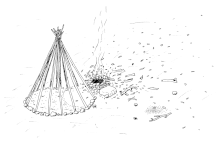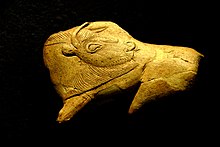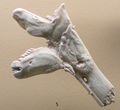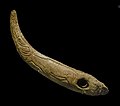Magdalenian
This article includes a list of general references, but it lacks sufficient corresponding inline citations. (May 2021) |
 | |
| Geographical range | Western Europe |
|---|---|
| Period | Upper Paleolithic Mesolithic |
| Dates | c. 17,000 – c. 12,000 BP[a] |
| Type site | Abri de la Madeleine |
| Major sites | Cave of Altamira, Kents Cavern, Lascaux |
| Preceded by | Solutrean |
| Followed by | Azilian, Ahrensburg culture |
The Magdalenian cultures (also Madelenian;
department.Period biology

The Magdalenian epoch is represented by numerous sites, whose contents show progress in arts and culture. It was characterized by a cold and dry climate, humans in association with the reindeer, and the extinction of the mammoth. The use of bone and ivory as implements, begun in the preceding Solutrean epoch, increased, making the period essentially a bone period. Bone instruments are quite varied: spear-points, harpoon-heads, borers, hooks and needles.[citation needed]
The fauna of the Magdalenian epoch seems to have included tigers and other tropical species along with reindeer, arctic foxes, arctic hares, and other polar creatures. Magdalenian humans appear to have been of short stature, dolichocephalic, with a low retreating forehead and prominent brow ridges.[citation needed]
Chronology
The culture spans from approximately 17,000 to 12,000 BP, toward the end of the most recent ice age. Magdalenian tool culture is characterised by regular blade industries struck from carinated cores.
The Magdalenian epoch is divided into six phases generally agreed to have chronological significance (Magdalenian I through VI, I being the earliest and VI being the latest). The earliest phases are recognised by the varying proportion of blades and specific varieties of scrapers, the middle phases marked by the emergence of a microlithic component (particularly the distinctive

Debate continues about the nature of the earliest Magdalenian assemblages, and it remains questionable whether the Badegoulian culture is the earliest phase of Magdalenian culture. Similarly, finds from the forest of Beauregard near Paris have been suggested as belonging to the earliest Magdalenian.
The later phases of Magdalenian culture are contemporaneous with the human re-settlement of north-western Europe after the
As hunter gatherers, Magdalenians did not re-settle permanently in northwest Europe, instead following herds and seasons.By the end of the Magdalenian epoch, lithic technology shows a pronounced trend toward increased microlithisation. The bone harpoons and points have the most distinctive chronological markers within the typological sequence. As well as flint tools, Magdalenians are known for their elaborate worked bone, antler and
The sea shells and fossils found in Magdalenian sites may be sourced to relatively precise areas and have been used to support hypotheses of Magdalenian hunter-gatherer seasonal ranges, and perhaps trade routes.
In northern Spain and south-west France this tool culture was superseded by the
Art

Bones, reindeer antlers and animal teeth display pictures carved or etched on them of seals, fish, reindeer, mammoths and other creatures.
The best of Magdalenian artworks are a mammoth engraved on a fragment of its own ivory;[dubious ] a dagger of reindeer antler, with a handle in form of a reindeer; a cave-bear cut on a flat piece of schist; a seal on a bear's tooth; a fish drawn on a reindeer antler; and a complete picture, also on reindeer antler, showing horses, an aurochs, trees, and a snake biting a man's leg. The man is naked, which, together with the snake, suggests a warm climate in spite of the presence of the reindeer.
In the
Examples of Magdalenian portable art include batons, figurines, and intricately engraved projectile points, as well as items of personal adornment including sea shells, perforated carnivore teeth (presumably necklaces), and fossils.
Cave sites such as
Gallery
Treatment of the dead
Some skulls were cleaned of soft tissues, then had the facial regions removed, with the remaining brain case retouched, possibly to make the broken edges more regular. This manipulation suggests the shaping of skulls to produce skull cups.[10]
Genetics
The genes of seven Magdalenians, the
The three samples of
In a genetic study published in
See also
| The Paleolithic |
|---|
| ↑ Pliocene (before Homo) |
| ↓ Mesolithic |
- Magdalenian Girl
- Swimming Reindeer
- Art of the Upper Paleolithic
- List of Stone Age art
- Haplogroup I (Y-DNA)
- Pre-Celtic
References
Notes
Footnotes
- ^ "The Magdalenian". Les Eyzies Tourist Info. Archived from the original on 2021-01-18. Retrieved 2019-09-28.
- ^ Enloe 2001.
- ^ de Sonneville-Bordes & Perrot 1956.
- ^ "Pincevent; a prehistoric site museum". UNESCO.
- ^ Hemingway 1980.
- ^ Housley et al. 1997.
- ^ Charles 1996.
- ^ <Madeleine Muzdakis> (January 26, 2021). "15,000-Year-Old Bison Sculptures Are Perfectly Preserved in a French Cave". My Modern Met. Retrieved January 29, 2021.
- ^ Conkey et al. 1980.
- PMID 21359211.
- ^ Fu et al. 2016.
- PMID 36859578.)
{{cite journal}}: CS1 maint: multiple names: authors list (link - ^ "Scientists Sequence Genomes of Prehistoric Hunter-Gatherers from Different Eurasian Cultures". Sci.News. 2 March 2023.
- PMID 36280785.
Bibliography
- This article incorporates text from a publication now in the public domain: Chisholm, Hugh, ed. (1911). "Madelenian". Encyclopædia Britannica. Vol. 17 (11th ed.). Cambridge University Press. pp. 283–284.
- Charles, Ruth (1996). "Back into the North: the Radiocarbon Evidence for the Human Recolonisation of the North-Western Ardennes after the Last Glacial Maximum". Proceedings of the Prehistoric Society. 62: 1–17. S2CID 128580542.
- Conkey, M.W.; Beltrán, A.; Clark, G.A.; Echegaray, J.G.; Guenther, M.G.; Hahn, J.; Hayden, B.; Paddayya, K.; Straus, L.G.; Valoch, K. (October 1980). "The Identification of Prehistoric Hunter-Gatherer Aggregation Sites: The Case of Altamira [and Comments and Reply]". Current Anthropology. 21 (5): 609–630. S2CID 145367811.
- Enloe, J. (2001). "Magdalenian". In Peregrine, P.N.; Ember, M. (eds.). Encyclopedia of Prehistory. Boston, MA: Springer. pp. 198–209. ISBN 978-1-4684-7131-1.
- Fu, Q.; Posth, C.; Hajdinjak, M.; et al. (May 2, 2016). "The genetic history of Ice Age Europe". PMID 27135931.
- Hemingway, M.F. (1980). The Initial Magdalenian in France. B.A.R. OCLC 7368169.
- Housley, R.A.; Gamble, C.S.; Street, M.; Pettitt, P. (1997). "Radiocarbon evidence for the Lateglacial Human Recolonisation of Northern Europe". Proceedings of the Prehistoric Society. 63: 25–54. S2CID 130323509.
- Lartet, E.; Christy, H. (1875). Reliquae Aquitanicae: being contributions to the archaeology of Périgord and adjoining provinces of Southern France. London: Williams & Norgate.
- de Sonneville-Bordes, D.; Perrot, J. (1956). "Lexique typologique du Paléolithique supérieur". Bulletin de la Société préhistorique de France. 53 (7): 408–412. ISSN 0037-9514.
- Straus, Lawrence Guy (1992). Iberia Before the Iberians. University of New Mexico Press.
External links
- "Pictures and description of the La Madeleine site". 2009-03-01. Archived from the original on 2009-03-01. Retrieved 2019-09-28.
- Picture Gallery of the Paleolithic (reconstructional palaeoethnology), Libor Balák at the Czech Academy of Sciences, the Institute of Archaeology in Brno, The Center for Paleolithic and Paleoethnological Research




























